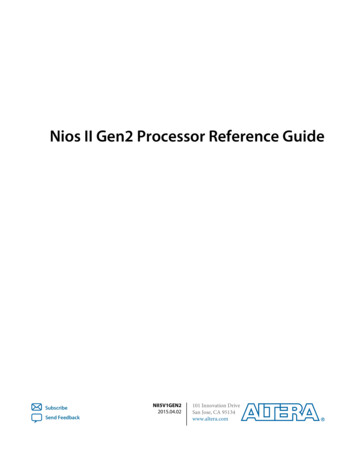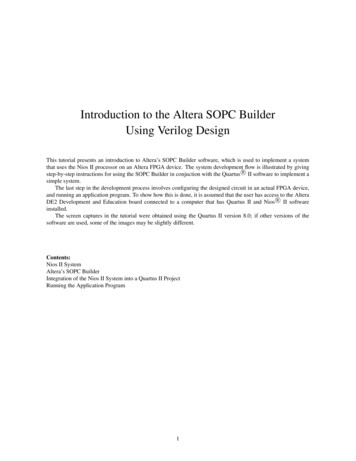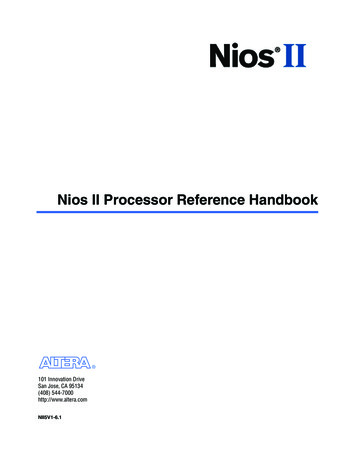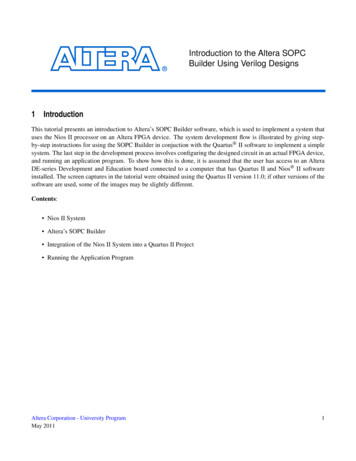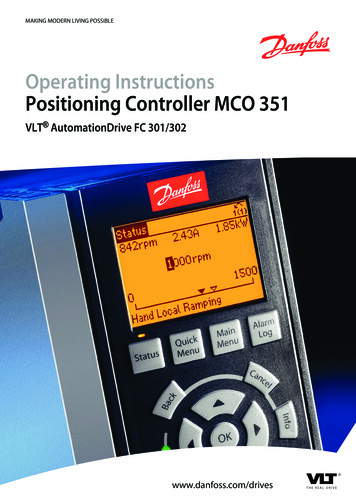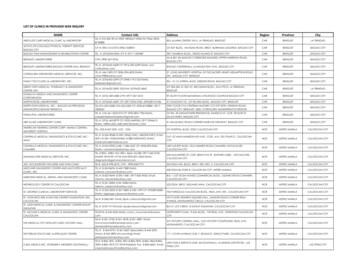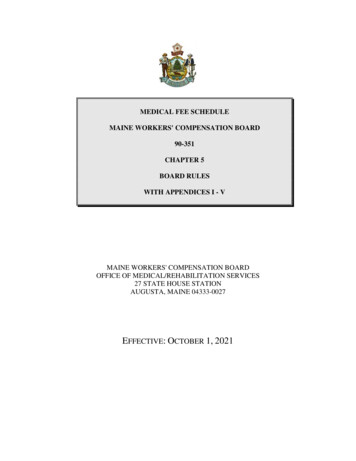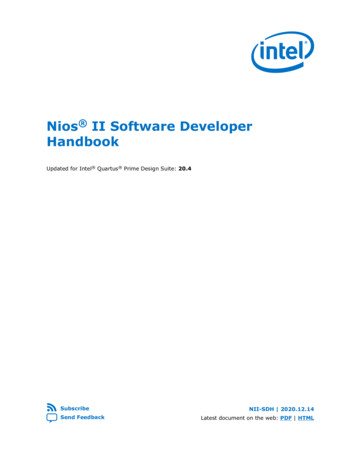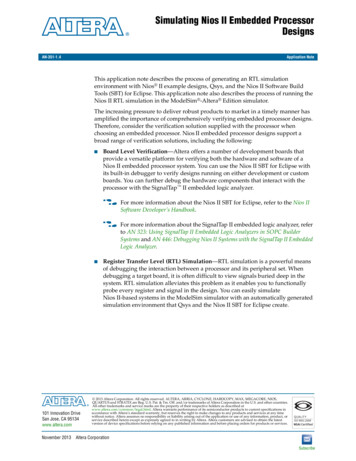
Transcription
Simulating Nios II Embedded ProcessorDesignsAN-351-1.4Application NoteThis application note describes the process of generating an RTL simulationenvironment with Nios II example designs, Qsys, and the Nios II Software BuildTools (SBT) for Eclipse. This application note also describes the process of running theNios II RTL simulation in the ModelSim -Altera Edition simulator.The increasing pressure to deliver robust products to market in a timely manner hasamplified the importance of comprehensively verifying embedded processor designs.Therefore, consider the verification solution supplied with the processor whenchoosing an embedded processor. Nios II embedded processor designs support abroad range of verification solutions, including the following: Board Level Verification—Altera offers a number of development boards thatprovide a versatile platform for verifying both the hardware and software of aNios II embedded processor system. You can use the Nios II SBT for Eclipse withits built-in debugger to verify designs running on either development or customboards. You can further debug the hardware components that interact with theprocessor with the SignalTap II embedded logic analyzer.f For more information about the Nios II SBT for Eclipse, refer to the Nios IISoftware Developer’s Handbook.f For more information about the SignalTap II embedded logic analyzer, referto AN 323: Using SignalTap II Embedded Logic Analyzers in SOPC BuilderSystems and AN 446: Debugging Nios II Systems with the SignalTap II EmbeddedLogic Analyzer. 101 Innovation DriveSan Jose, CA 95134www.altera.comNovember 2013Register Transfer Level (RTL) Simulation—RTL simulation is a powerful meansof debugging the interaction between a processor and its peripheral set. Whendebugging a target board, it is often difficult to view signals buried deep in thesystem. RTL simulation alleviates this problem as it enables you to functionallyprobe every register and signal in the design. You can easily simulateNios II-based systems in the ModelSim simulator with an automatically generatedsimulation environment that Qsys and the Nios II SBT for Eclipse create. 2013 Altera Corporation. All rights reserved. ALTERA, ARRIA, CYCLONE, HARDCOPY, MAX, MEGACORE, NIOS,QUARTUS and STRATIX are Reg. U.S. Pat. & Tm. Off. and/or trademarks of Altera Corporation in the U.S. and other countries.All other trademarks and service marks are the property of their respective holders as described atwww.altera.com/common/legal.html. Altera warrants performance of its semiconductor products to current specifications inaccordance with Altera’s standard warranty, but reserves the right to make changes to any products and services at any timewithout notice. Altera assumes no responsibility or liability arising out of the application or use of any information, product, orservice described herein except as expressly agreed to in writing by Altera. Altera customers are advised to obtain the latestversion of device specifications before relying on any published information and before placing orders for products or services.Altera CorporationSubscribe
Page 2Before You BeginBefore You BeginThis document assumes that you have prior experience using Qsys as well as afamiliarity with the ModelSim simulator. In order to simulate the Nios II design usingthe instructions in this document, you must have the following software installed: The Quartus II software version 11.0 or later ModelSim-Altera Edition version 6.6d or higher Nios II Embedded Design Suite version 11.0 or laterSetting Up and Generating Your Simulation Environment in QsysTo open the example design, perform the following steps:1. Download the an351 design.zip design example from the Simulating Nios IIEmbedded Processor Design page on the Altera website, and then extract thedesign example to your hard drive. The location to which you extract the file isreferred to as your project directory throughout the remainder of this document.2. Start the Quartus II software.3. On the File menu, click Open Project.4. Browse to your project directory /an351 design.5. Select an351 project.qpf.6. Click Open.7. On the Tools menu, click Qsys.8. Open the niosii system.qsys file.1The design example used for this application note is a complete Qsyssystem. Ensure that you have completed building your Qsys system beforeyou start to generate the simulation models.9. On the Generation tab, set the following parameters to these values: Create simulation model—None Create testbench Qsys system—Simple, BFMs for clocks and resets1If your system has exported ports other than the clock and reset, chooseStandard, BFMs for standard Avalon interfaces. Create testbench simulation model—Verilog Create HDL design files for synthesis—Turn off Create block symbol file (.bsf)—Turn off10. Click Generate. Save the system if prompted.Simulating Nios II Embedded Processor DesignsNovember 2013 Altera Corporation
Creating the Nios II SoftwarePage 3Qsys-Generated System Simulation FilesAt this point in the design flow, Qsys has generated your system and created all of thefiles necessary for simulation listed in Table 1. These simulation files are located in the your project directory /an351 design/niosii system/testbench directory.Table 1. Qsys Files Generated for Nios II SimulationFileDescriptionQsys testbenchsystem filesQsys generates a testbench system when you enable the Create testbench Qsys system option. Qsysconnects the corresponding Avalon Bus Functional Models to all exported interfaces of your system.For more information about Qsys, refer to the System Design with Qsys section in volume 1 of theQuartus II Handbook.msim setup.tclSets up a ModelSim simulation environment and creates alias commands to compile the requireddevice libraries and system design files in the correct order, and loads the top-level design forsimulation.MemoryInitialization Files(.mif)Creates Memory Initialization Files (.mif) to initialize memory components in your system. UseNios II SBT for Eclipse to create Nios II processor program to populate the .mif files.Memory Simulation ModelsYou can use two types of memory models for simulation purposes: generic andvendor-specific. For Altera-provided memory controllers, you are provided withgeneric simulation models. If you are using custom memory controllers, you shoulduse the simulation models the memory controller vendor provides. This applicationnote discusses the generic memory model.Using IP and Qsys Simulation Setup ScriptsAltera IP cores and Qsys systems generate simulation setup scripts. Modify thesescripts to set up supported simulators.For more information on generating custom simulation scripts, please refer to theUsing IP and Qsys Simulation Setup Scripts (Custom Flow) section of the Quartus IIHandbook Version 13.1.Creating the Nios II SoftwareThis section describes how to finish setting up your simulation by using the Nios IISBT for Eclipse to create a software test project and to generate the necessary files forinitializing the memories used in your simulation.Creating a Nios II SBT for Eclipse ProjectIn this application note, you simulate a simple Hello World program with Qsys. TheHello World software prints a message to the console via JTAG UART. To create andbuild the software project, perform the following steps:1. Open the Nios II SBT for Eclipse version 11.0 or later.2. On the File menu, point to New, and click Nios II Application and BSP fromTemplate.November 2013Altera CorporationSimulating Nios II Embedded Processor Designs
Page 4Running Simulation in the ModelSim Simulator3. Select the SOPC Information (.sopcinfo) file name by browsing to your projectdirectory /an351 design, and then select niosii system.sopcinfo.4. For Project Name, type hello world an351.5. Select Hello World from the Templates option.6. Click Finish.7. Right-click on hello world an351 in Project Explorer and then click Build Project.Now you have successfully built the Hello World project. In the next step, you willinvoke ModelSim simulation from the Nios II SBT for Eclipse. This function populatesthe Memory Initialization File (.mif) with the Hello World program and starts theModelSim software.8. Right-click on hello world an351 in Project Explorer. Point to Run As, and thenclick Nios II ModelSim.Running Simulation in the ModelSim SimulatorAfter you have launched the ModelSim simulator from the Nios II SBT for Eclipse,ModelSim automatically compiles the required device libraries and system designfiles, and elaborates and loads the top-level design. The msim setup.tcl script createsalias commands for each of the steps. These commands are listed in Table 2.Table 2. Nios II Alias CommandsMacrosdev comDescriptionCompiles device library files.comCompiles the design files in correct order.elabElaborates the top-level design.elab debugldld debugElaborates the top-level design with the novopt option.Compiles all the design files and elaborates the top-level design.Compiles all the design files and elaborates the top-level design with the novopt option.Run the simulation in the ModelSim simulator by performing the following steps:1. In the ModelSim software, on the File menu, click Load. Browse to your projectdirectory /an351 design and select wave.do. This step opens a waveform viewerwith all the JTAG UART signals.2. In the Transcript window, type run 2 ms. This step starts the simulation for twomilliseconds.At the end of the simulation, you should see a “Hello from Nios II!” message in theTranscript window. You can observe the simulation results from the waveform vieweras well. Figure 1 shows the simulation result. The waveform is zoomed in at a specificsimulation time in which the Nios II processor writes the first H character to theJTAG UART component.Simulating Nios II Embedded Processor DesignsNovember 2013 Altera Corporation
ConclusionPage 5Figure 1. Simulation ResultsConclusionSimulation and verification are vital parts of the design process. You cancomprehensively verify the Nios II processors with board-level debugging, and RTLsimulation with the ModelSim simulator. RTL simulation is an important part of thedesign process, particularly for configurable systems, because it enables you to probedeeply embedded signals in the processor and your peripheral set. RTL simulationalso helps verify your system before you try out your design in the actual hardware.Document Revision HistoryTable 3 shows the revision history for this document.Table 3. Document Revision HistoryDateVersionChangesNovember 20131.4Added the “Using IP and Qsys Simulation Setup Scripts” section.June 20111.3Updated for the Nios II processor 11.0 releaseNovember 20081.2Updated for the Nios II processor 8.1 releaseNovember 20071.1Updated for the Nios II processor 7.2 releaseMay 2001‘1.0Initial release.November 2013Altera CorporationSimulating Nios II Embedded Processor Designs
environment with Nios II example designs, Qsys, and the Nios II Software Build Tools (SBT) for Eclipse. This application note also describes the process of running the Nios II RTL simulation in the ModelSim -Altera Edition simulator. The increasing pressure to deliver robust products to market in a timely manner has
